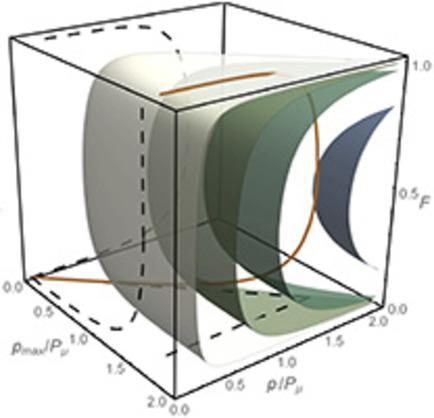当前位置:
X-MOL 学术
›
Propellants Explos. Pyrotech.
›
论文详情
Our official English website, www.x-mol.net, welcomes your feedback! (Note: you will need to create a separate account there.)
A Simple Reactive‐Flow Model for Corner‐Turning in Insensitive High Explosives, Including Failure and Dead Zones. I. The Model.
Propellants, Explosives, Pyrotechnics ( IF 1.8 ) Pub Date : 2020-08-12 , DOI: 10.1002/prep.201900383 Peter Todd Williams 1
Propellants, Explosives, Pyrotechnics ( IF 1.8 ) Pub Date : 2020-08-12 , DOI: 10.1002/prep.201900383 Peter Todd Williams 1
Affiliation

|
I report on a novel simple reactive‐flow model that captures corner‐turning behavior, including failure and the creation of dead zones, in insensitive solid heterogeneous high explosives. The model is fast, has a minimum of free parameters, and is physically grounded in the underlying initiation and burn phenomena. The focus of the model is explosives based on triaminotrinitrobenzene (TATB), although the model is quite general. I initially developed the model and integrated it into a branch of a Lawrence Livermore National Laboratory (LLNL) arbitrary Lagrangian‐Eulerian (ALE) code concurrently with other modelling efforts of mine, but I subsequently adopted it to study corner‐turning behavior in the TATB‐based high explosive PBX 9502 when two other available models suggested to me proved inadequate, being either prohibitively computationally expensive or numerically unstable. An early version of the model reproduces corner‐turning behavior in two different double‐cylinder tests and a mushroom‐type corner turning test. The model was informed and influenced by other reactive‐flow models applicable to shock initiation or corner‐turning, most especially including JWL++ Tarantula 2011 and an in‐house piecewise‐linear CHEETAH‐based model that exhibits corner‐turning behavior, but also, to a degree, by Ignition & Growth (I&G), CREST, and the Statistical Hot‐Spot Model. The model also shares some similarities to SURF models. In this paper, I describe the model and its theoretical development as I originally conceived it, as well as subsequent improvements.
中文翻译:

一个简单的反应流模型,用于不敏感的高炸药的转弯,包括失效区和死区。一,模型。
我报告了一种新颖的简单反应流模型,该模型捕获了不敏感的固体异质高能炸药中的转弯行为,包括失效和死区的产生。该模型很快,具有最少的自由参数,并且在物理上扎根于潜在的起爆现象和燃烧现象。该模型的重点是基于三氨基三硝基苯(TATB)的炸药,尽管该模型相当笼统。最初,我开发了模型,然后将其集成到劳伦斯·利弗莫尔国家实验室(LLNL)的任意拉格朗日欧拉(ALE)代码的分支中,并与我的其他建模工作同时进行,但随后我将其用于研究TATB中的转弯行为。基于高爆炸性的PBX 9502,但另外两个可用的模型向我建议不足,在计算上过于昂贵或在数值上不稳定。该模型的早期版本在两个不同的双缸测试和蘑菇型转弯测试中再现了转弯行为。该模型受到其他适用于冲击发生或转弯的反应流模型的影响,尤其是包括JWL ++ Tarantula 2011和基于分段分段线性CHEETAH的内部模型,该模型表现出转弯行为,而且还具有以下特点:点火和增长(I&G),CREST和统计热点模型获得的学位。该模型还与SURF模型具有一些相似之处。在本文中,我描述了该模型及其最初的构想以及后来的改进。该模型的早期版本在两个不同的双缸测试和蘑菇型转弯测试中再现了转弯行为。该模型受到其他适用于冲击发生或转弯的反应流模型的影响,尤其是包括JWL ++ Tarantula 2011和基于分段分段线性CHEETAH的内部模型,该模型表现出转弯行为,而且还具有以下特点:点火和增长(I&G),CREST和统计热点模型获得的学位。该模型还与SURF模型具有一些相似之处。在本文中,我描述了该模型及其最初的构想以及后来的改进。该模型的早期版本在两个不同的双缸测试和蘑菇型转弯测试中再现了转弯行为。该模型受到其他适用于冲击发生或转弯的反应流模型的影响,尤其是包括JWL ++ Tarantula 2011和基于分段分段线性CHEETAH的内部模型,该模型表现出转弯行为,而且还具有以下特点:点火和增长(I&G),CREST和统计热点模型获得的学位。该模型还与SURF模型具有一些相似之处。在本文中,我描述了该模型及其最初的构想以及后来的改进。该模型受到其他适用于冲击发生或转弯的反应流模型的影响,尤其是包括JWL ++ Tarantula 2011和基于分段分段线性CHEETAH的内部模型,该模型表现出转弯行为,而且还具有以下特点:点火和增长(I&G),CREST和统计热点模型获得的学位。该模型还与SURF模型具有一些相似之处。在本文中,我描述了该模型及其最初的构想以及后来的改进。该模型受到其他适用于冲击发生或转弯的反应流模型的影响,尤其是包括JWL ++ Tarantula 2011和基于分段分段线性CHEETAH的内部模型,该模型表现出转弯行为,而且还具有以下特点:点火和增长(I&G),CREST和统计热点模型获得的学位。该模型还与SURF模型具有一些相似之处。在本文中,我描述了该模型及其最初的构想以及后来的改进。该模型还与SURF模型具有一些相似之处。在本文中,我描述了该模型及其最初的构想以及后来的改进。该模型还与SURF模型具有一些相似之处。在本文中,我描述了该模型及其最初的构想以及后来的改进。
更新日期:2020-10-05
中文翻译:

一个简单的反应流模型,用于不敏感的高炸药的转弯,包括失效区和死区。一,模型。
我报告了一种新颖的简单反应流模型,该模型捕获了不敏感的固体异质高能炸药中的转弯行为,包括失效和死区的产生。该模型很快,具有最少的自由参数,并且在物理上扎根于潜在的起爆现象和燃烧现象。该模型的重点是基于三氨基三硝基苯(TATB)的炸药,尽管该模型相当笼统。最初,我开发了模型,然后将其集成到劳伦斯·利弗莫尔国家实验室(LLNL)的任意拉格朗日欧拉(ALE)代码的分支中,并与我的其他建模工作同时进行,但随后我将其用于研究TATB中的转弯行为。基于高爆炸性的PBX 9502,但另外两个可用的模型向我建议不足,在计算上过于昂贵或在数值上不稳定。该模型的早期版本在两个不同的双缸测试和蘑菇型转弯测试中再现了转弯行为。该模型受到其他适用于冲击发生或转弯的反应流模型的影响,尤其是包括JWL ++ Tarantula 2011和基于分段分段线性CHEETAH的内部模型,该模型表现出转弯行为,而且还具有以下特点:点火和增长(I&G),CREST和统计热点模型获得的学位。该模型还与SURF模型具有一些相似之处。在本文中,我描述了该模型及其最初的构想以及后来的改进。该模型的早期版本在两个不同的双缸测试和蘑菇型转弯测试中再现了转弯行为。该模型受到其他适用于冲击发生或转弯的反应流模型的影响,尤其是包括JWL ++ Tarantula 2011和基于分段分段线性CHEETAH的内部模型,该模型表现出转弯行为,而且还具有以下特点:点火和增长(I&G),CREST和统计热点模型获得的学位。该模型还与SURF模型具有一些相似之处。在本文中,我描述了该模型及其最初的构想以及后来的改进。该模型的早期版本在两个不同的双缸测试和蘑菇型转弯测试中再现了转弯行为。该模型受到其他适用于冲击发生或转弯的反应流模型的影响,尤其是包括JWL ++ Tarantula 2011和基于分段分段线性CHEETAH的内部模型,该模型表现出转弯行为,而且还具有以下特点:点火和增长(I&G),CREST和统计热点模型获得的学位。该模型还与SURF模型具有一些相似之处。在本文中,我描述了该模型及其最初的构想以及后来的改进。该模型受到其他适用于冲击发生或转弯的反应流模型的影响,尤其是包括JWL ++ Tarantula 2011和基于分段分段线性CHEETAH的内部模型,该模型表现出转弯行为,而且还具有以下特点:点火和增长(I&G),CREST和统计热点模型获得的学位。该模型还与SURF模型具有一些相似之处。在本文中,我描述了该模型及其最初的构想以及后来的改进。该模型受到其他适用于冲击发生或转弯的反应流模型的影响,尤其是包括JWL ++ Tarantula 2011和基于分段分段线性CHEETAH的内部模型,该模型表现出转弯行为,而且还具有以下特点:点火和增长(I&G),CREST和统计热点模型获得的学位。该模型还与SURF模型具有一些相似之处。在本文中,我描述了该模型及其最初的构想以及后来的改进。该模型还与SURF模型具有一些相似之处。在本文中,我描述了该模型及其最初的构想以及后来的改进。该模型还与SURF模型具有一些相似之处。在本文中,我描述了该模型及其最初的构想以及后来的改进。



























 京公网安备 11010802027423号
京公网安备 11010802027423号